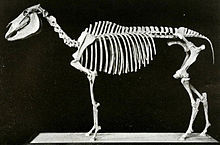Equus scotti
| Equus scotti Temporal range: Early Pleistocene–Late Pleistocene PreꞒ Ꞓ O S D C P T J K Pg N ↓ | |
|---|---|
 | |
| A mounted skeleton of Equus scotti at the AMNH, constructed out of two skeletons | |
| Scientific classification | |
| Domain: | Eukaryota |
| Kingdom: | Animalia |
| Phylum: | Chordata |
| Class: | Mammalia |
| Order: | Perissodactyla |
| Family: | Equidae |
| Genus: | Equus |
| Species: | †E. scotti |
| Binomial name | |
| †Equus scotti Gidley, 1900 | |
| Synonyms | |
| †Equus bautistensis | |
Equus scotti (translated from Latin as Scott's horse,[1] named after vertebrate paleontologist William Berryman Scott) is an extinct species of horse native to Pleistocene North America.[2]
Evolution


Equus scotti is a true caballine horse that is more closely related to modern horses than to zebras and asses. Equus scotti may be synonymous with Equus lambei, another generally smaller horse known from the Pleistocene of North America, but this is uncertain.[3] Although it has been suggested that Equus scotti may be synonymous with living Equus ferus[3], North American horses diverged from their Eurasian counterparts around 800,000 years ago, following the first dispersal of horses out of North America, with some interbreeding after the initial split.[4]
The earliest remains of the species are known from the late Blancan during the Early Pleistocene. The youngest remains of the species date to the Late Pleistocene (Rancholabrean) around 12,000 years ago.[3]
Distribution
Paleontological excavations have identified the locations of numerous places where E. scotti occurred. The species was named from Rock Creek, Texas, United States, where multiple skeletons were recovered. A closely related fossil find was made of Equus bautistensis in California; this species appeared closely related, but of a slightly more primitive form than E. scotti.[5] However, E. bautistensis was redefined as a junior synonym of E. scotti in 1998 by paleontologist E. Scott,[6] who also assigned fossils from the Anza-Borrego Desert in California, tentatively interpreted to represent E. bautistensis, to E. scotti.[7]
The distribution of the species includes: "Alberta, Ontario, Saskatchewan and Yukon (Canada) and in California, Florida, Idaho, Kansas, Nebraska, New Mexico, Oklahoma and Texas (United States)".[3]
See also
References
- ^ ISBN 0-8020-4817-X
- ^ "The Paleobiology Database". Archived from the original on 2012-10-12. Retrieved 2009-01-22.
- ^ a b c d Cirilli, Omar; Machado, Helena; Arroyo-Cabrales, Joaquin; Barrón-Ortiz, Christina I.; Davis, Edward; Jass, Christopher N.; Jukar, Advait M.; Landry, Zoe; Marín-Leyva, Alejandro H.; Pandolfi, Luca; Pushkina, Diana; Rook, Lorenzo; Saarinen, Juha; Scott, Eric; Semprebon, Gina (2022-08-24). "Evolution of the Family Equidae, Subfamily Equinae, in North, Central and South America, Eurasia and Africa during the Plio-Pleistocene". Biology. 11 (9): 1258. doi:10.3390/biology11091258. ISSN 2079-7737. PMC 9495906. PMID 36138737.
- ^ Vershinina, Alisa O.; Heintzman, Peter D.; Froese, Duane G.; Zazula, Grant; Cassatt-Johnstone, Molly; Dalén, Love; Der Sarkissian, Clio; Dunn, Shelby G.; Ermini, Luca; Gamba, Cristina; Groves, Pamela; Kapp, Joshua D.; Mann, Daniel H.; Seguin-Orlando, Andaine; Southon, John (December 2021). "Ancient horse genomes reveal the timing and extent of dispersals across the Bering Land Bridge". Molecular Ecology. 30 (23): 6144–6161. Bibcode:2021MolEc..30.6144V. doi:10.1111/mec.15977. hdl:10037/24463. ISSN 0962-1083. PMID 33971056. S2CID 234360028.
- ^ Childs Frick (1921) Extinct Vertebrate Faunas of the Badlands of Bautista Creek and San Timoteo Cañon, Southern California, University of California Press, 424 pages
- ^ Eric Scott (1998) Equus scotti from southern California, Journal of Vertebrate Paleontology 18(3): 76-A
- ^ Eric Scott (2006) Extinct horses and their relatives, Fossil Treasures of the Anza-Borrego Desert: the Last Seven Million Years, ed. G.T. Jefferson and L. Lindsey, Sunbelt Publications, p. 253 - 271
- v
- t
- e
| African wild ass (Equus africanus) |
|
|---|---|
| Onager / Asiatic wild ass (Equus hemionus) |
|
| Kiang/Tibetan wild ass (Equus kiang) |
|
| Wild horse (Equus ferus) |
|
|---|
| Plains zebra (Equus quagga) |
|
|---|---|
| Mountain zebra (Equus zebra) |
|
| Grévy's zebra (Equus grevy) |
|
Equus species
- †Equus alaskae
- †Equus andium
- †Giant Cape zebra (Equus capensis)
- †Equus cedralensis
- †Equus complicatus
- †Equus conversidens
- †Equus crinidens
- †Equus cumminsii
- †Equus dalianensis
- †Equus excelsus
- †Equus fraternus
- †Equus gallicus
- †Equus giganteus
- †Equus lambei
- †Equus latipes
- †Equus lenensis
- †Equus mauritanicus
- †Equus mexicanus
- †Equus namadicus
- †Equus niobrarensis
- †Equus occidentalis
- †Equus pacificus
- †Equus parastylidens
- †Equus pectinatus
- †Hagerman horse (Equus simplicidens)
- †Equus semiplicatus
- †Equus scotti
- †Equus sivalensis
- †Equus stenonis
- †Equus uralensis
- †Equus yunnanensis









